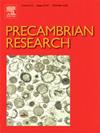Regulation of carbon–nitrogen cycle by chemoautotrophic bacteria during the early Cambrian: Evidence from the silicate-bound nitrogen in the Yangtze Block, South China
IF 3.2
2区 地球科学
Q2 GEOSCIENCES, MULTIDISCIPLINARY
引用次数: 0
Abstract
The Ediacaran-Cambrian (E–C) transition was a critical period in Earth’s history marked by environmental changes and an unprecedented biological evolution event. During the early Cambrian, carbon isotopes (δ13Ccarb and δ13Corg) exhibited multiple large negative excursions. The first and second excursions, known as the Basal Cambrian Carbon Isotope Excursion (BACE) and the Shiyantou Carbon Isotope Excursion (SHICE), are closely associated with the extinction of the Ediacaran biota and the small shelly biota, respectively. While it is hypothesized that intensified anoxic conditions contributed to the perturbations in carbon cycling and life evolution during the early Cambrian, the specific details of the mechanisms behind the negative carbon isotope excursions still require further investigation. Fixed ammonium is incorporated within the crystal structure of silicate minerals (mostly K-bearing phyllosilicates and feldspars) and is also referred to as silicate-bound nitrogen. It is the primary form of inorganic nitrogen in rocks and is increasingly being recognized for its role in reconstructing nitrogen cycles in paleo-oceans. In this study, we conducted detailed geochemical analyses of kerogen-bound nitrogen and silicate-bound nitrogen found in marine sequence from the lower Cambrian strata within the South China Craton. The isotopic composition of kerogen-bound nitrogen overall exhibits a negative excursion, indicating an expansion of the anoxic zone in seawater and a concomitant contraction of the nitrate reservoir during deposition of the Shuijingtuo Formation. The 15N-depleted signal of kerogen (<0‰) is concurrent with the notably elevated δ15Nsilicate values (up to 9.5 ‰) in the Shuijingtuo Member I, displaying offsets of up to 10.0 ‰. We attribute the abnormally high δ15Nsilicate values to intensified anammox associated with expansive anoxic bottom waters. Our research reveals a strong coupling between marine carbon and nitrogen cycles during the early Cambrian. Insofar as the biomass formed by carbon fixation coupled to ammonium oxidation is significantly depleted in 13C relative to CO2 in the atmosphere due to respiratory processes, the SHICE may be attributed to progressively greater inputs from these chemoautotrophic sources. This new explanation broadens our understanding of the mechanisms controlling the negative excursions of carbon isotopes during the early Cambrian. Furthermore, our results also suggest that applying the δ15Nkerogen and the δ15Nsilicate proxies, as observed in the lower Cambrian Shuijingtuo Formation, enables speculation on the origin of changes with analogous δ15N distributions associated with intensified anammox over other time periods.

求助全文
约1分钟内获得全文
求助全文
来源期刊

Precambrian Research
地学-地球科学综合
CiteScore
7.20
自引率
28.90%
发文量
325
审稿时长
12 months
期刊介绍:
Precambrian Research publishes studies on all aspects of the early stages of the composition, structure and evolution of the Earth and its planetary neighbours. With a focus on process-oriented and comparative studies, it covers, but is not restricted to, subjects such as:
(1) Chemical, biological, biochemical and cosmochemical evolution; the origin of life; the evolution of the oceans and atmosphere; the early fossil record; palaeobiology;
(2) Geochronology and isotope and elemental geochemistry;
(3) Precambrian mineral deposits;
(4) Geophysical aspects of the early Earth and Precambrian terrains;
(5) Nature, formation and evolution of the Precambrian lithosphere and mantle including magmatic, depositional, metamorphic and tectonic processes.
In addition, the editors particularly welcome integrated process-oriented studies that involve a combination of the above fields and comparative studies that demonstrate the effect of Precambrian evolution on Phanerozoic earth system processes.
Regional and localised studies of Precambrian phenomena are considered appropriate only when the detail and quality allow illustration of a wider process, or when significant gaps in basic knowledge of a particular area can be filled.
 求助内容:
求助内容: 应助结果提醒方式:
应助结果提醒方式:


